If you’ve ever tried to get honest feedback—from customers or your team—you know how hard it is. People hold back. They sugarcoat. And without the truth, you’re guessing your way through decisions.
That’s why anonymous surveys have become one of my favorite tools.
I first used them while scaling a SaaS business. Regular surveys weren’t cutting it. But when we made them anonymous, people suddenly opened up. That unfiltered feedback helped us fix issues we didn’t even know we had, and retention improved fast.
So, what is an Anonymous Survey?
In plain terms, it’s a survey where no personal information is collected. No names, no emails, no IPs—just honest opinions.
And that anonymity makes all the difference. It builds trust. It boosts response rates. And most importantly, it gives you the insights you actually need to grow. Let’s walk through how anonymous surveys work, why they matter, and exactly how to create one that drives results.
How to Create Anonymous Surveys
There are many anonymous survey tools out there, and I’ve tried more than I can count. But when it comes to creating truly anonymous surveys, most of them add extra steps to toggle anonymity on… or worse, track IPs and metadata by default.
Here, I’ve mentioned two ways to create anonymous surveys:
1. In-Context Surveys (Create Using Qualaroo)
No need to dig into settings or toggle privacy switches. You get complete anonymity by default. That’s why I picked it—because I didn’t want to gamble with trust when collecting sensitive feedback from my customers or employees.
Now, let me walk you through exactly how to create your own anonymous survey using Qualaroo:
Step 1: Choose ‘Link Nudge’ as Your Survey Type
Select ‘Link Nudge’, which lets you share the survey anywhere—email, Slack, internal portals, or social media. You can start from scratch or grab a ready-made template.
Why Link Nudges? They are perfect for anonymous surveys because they don’t tie responses to session or identity data.
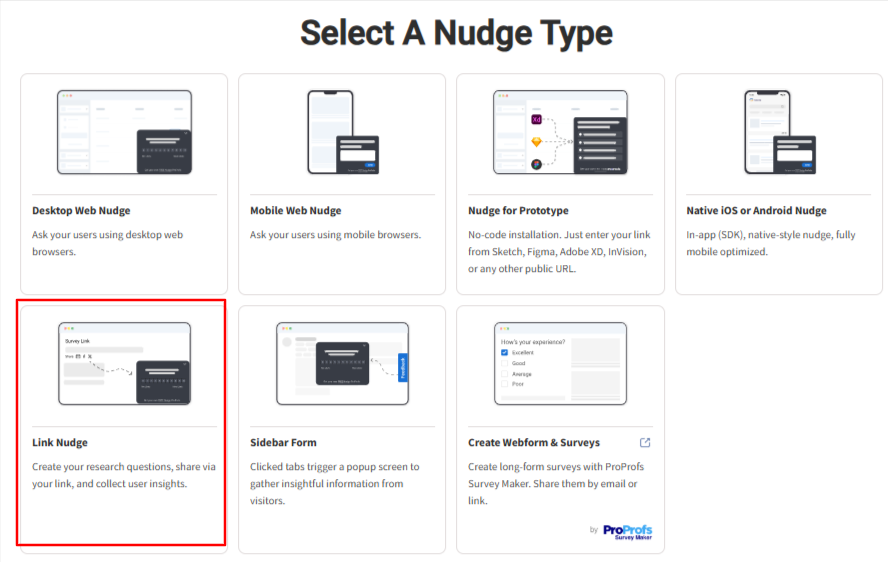
If you are wondering how to create a Link Survey, check this help guide.
Step 2: Draft Your Questions (with Privacy in Mind)
Under the Edit tab, add your questions, choose the answer types (e.g., multiple choice, text box), and write your response options.
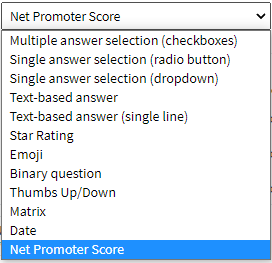
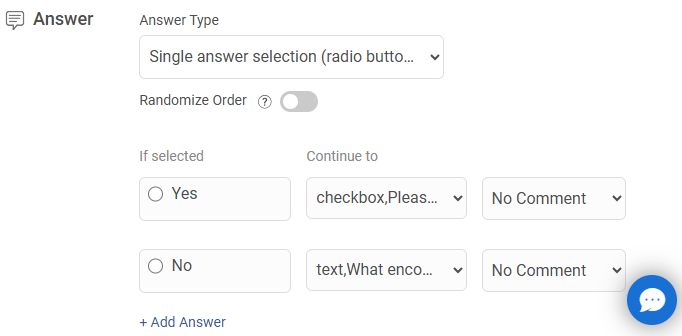
You can also choose your questions directly from Qualaroo’s prebuilt templates.
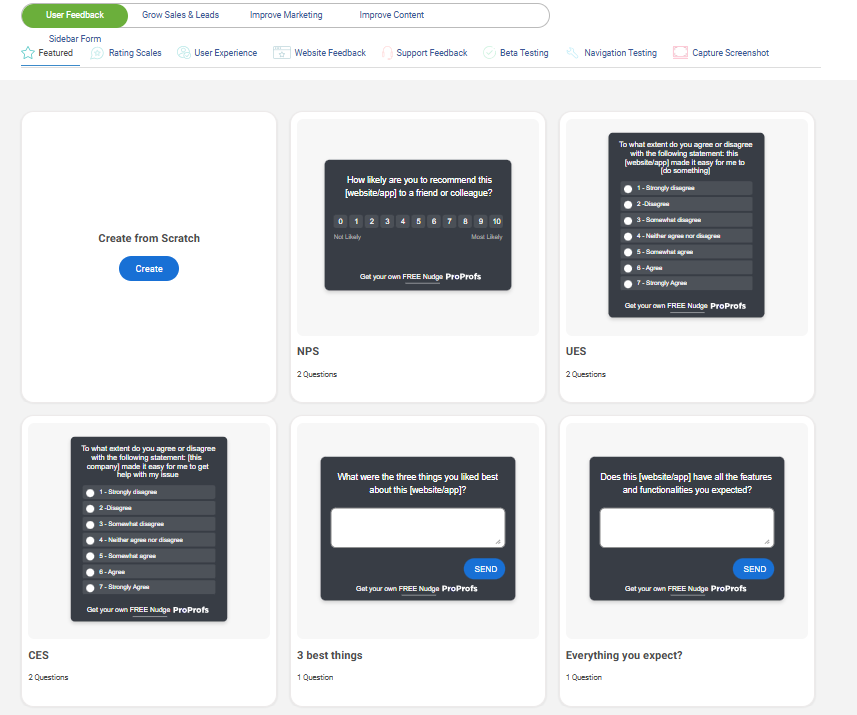
Pro Tip:
- Don’t ask for names, emails, or job titles—unless absolutely necessary and optional.
- Stick to short, clear questions that get to the heart of the issue.
Say you want to understand why users drop off during your free trial. You want honest answers—without making anyone feel exposed. You could ask:
- “What did you expect but didn’t find during the trial?”
- “Was anything confusing or unclear?”
- “What could have helped you get more value faster?”
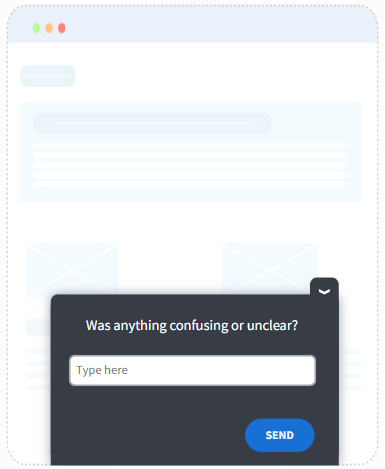
In your drop-off survey, you might include a friendly intro message like:
“We’re always improving—your honest (and anonymous) feedback can help us build a better experience.”
Step 3: Set Targeting Rules
Go to the Targeting tab to define when and to whom the survey appears.
For this example, you could:
- Show the survey only to users on the free trial plan
- Target users who have visited the dashboard multiple times (they’re engaged but may be unsure)
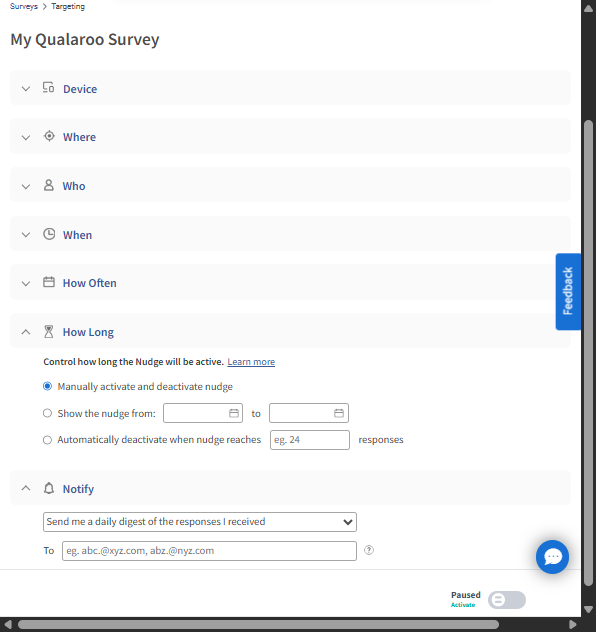
You can also learn how advanced survey targeting works (if not creating a link survey).
Step 4: Customize the Look & Feel
Head over to the Design tab to adjust branding elements like color, font, and logo. Keep it aligned with your product’s design so the experience feels seamless.

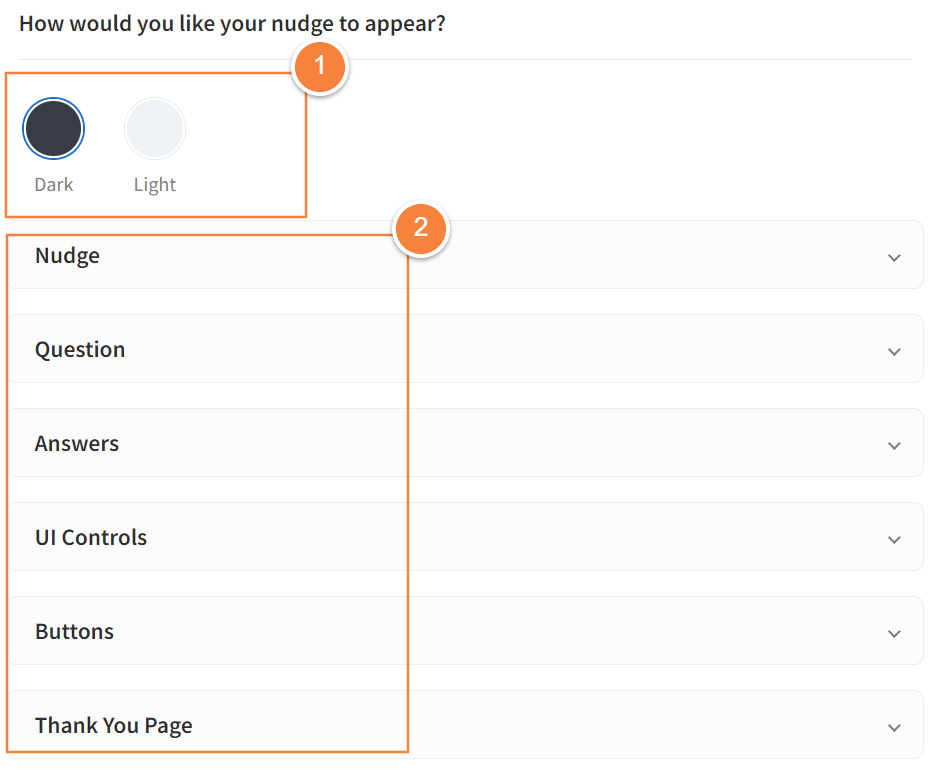
Step 5: Save, Activate & Share the Survey
Once your survey looks good, click Save and Activate.

You’ll get a unique link you can share through:
- Onboarding emails
- Product chat widgets (e.g., Intercom, Drift)
- A pop-up on your dashboard or logout screen
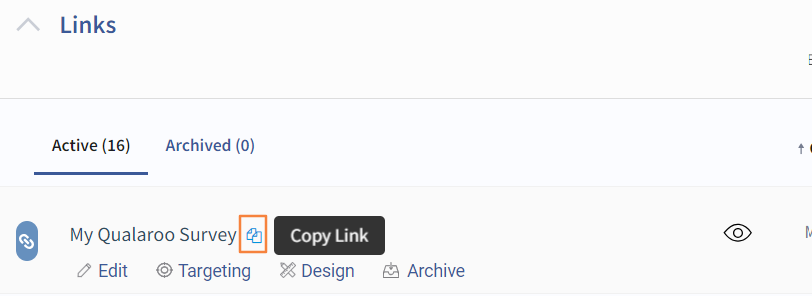
In the trial drop-off example, you could embed the survey in a “Sorry to see you go” message or schedule it as an automated check-in on Day 6.
2. Long-Form Email Surveys (Using ProProfs Suvey Maker)
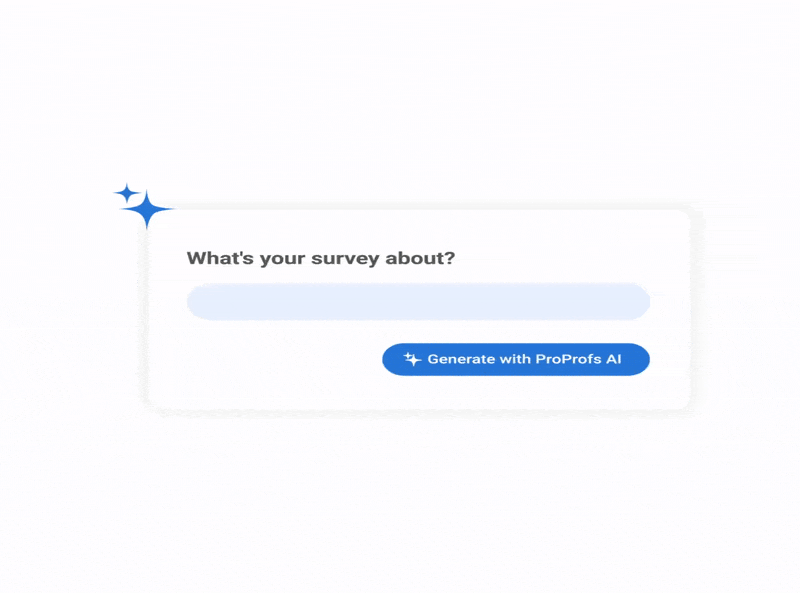
No need to wrestle with complicated settings or guess about privacy. With Survey Maker powered by ProProfs AI, creating an anonymous, on-brand survey is fast, easy, and worry-free. You can enable or disable anonymous survey settings, and then you are good to go!
Let me walk you through how to launch your own survey in just three simple steps:
Step 1: Tell ProProfs AI Your Survey Topic
Start by defining your survey’s focus. Just share what your survey is about—and if you want, specify language preferences to make sure it fits your audience perfectly.
This step helps ProProfs AI tailor questions and design suggestions that match your goals.
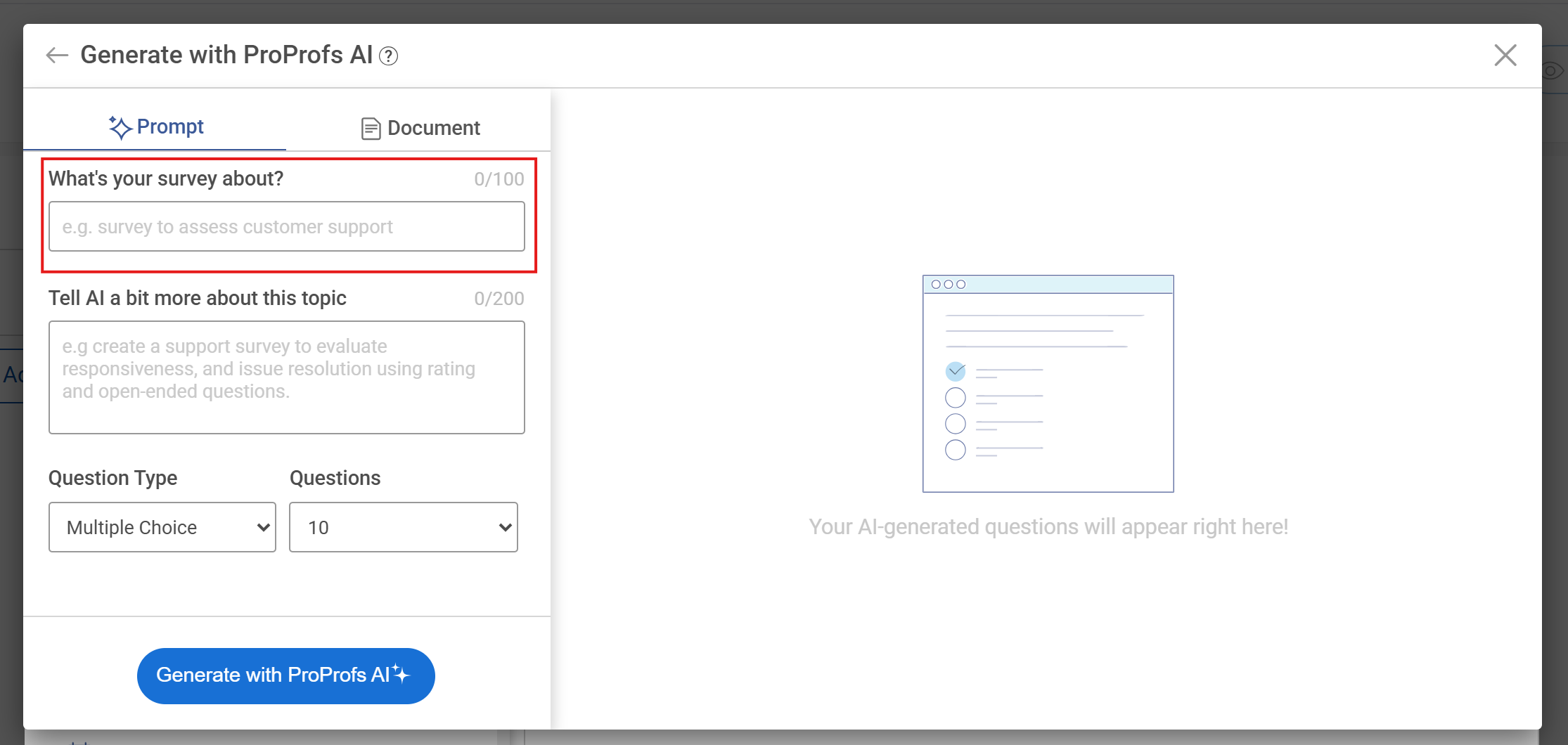
Step 2: Customize Your Survey Design
Make your survey truly yours by customizing its look and feel. Adjust colors, fonts, and layouts to align with your topic and brand style—so every respondent feels like they’re part of your unique experience.
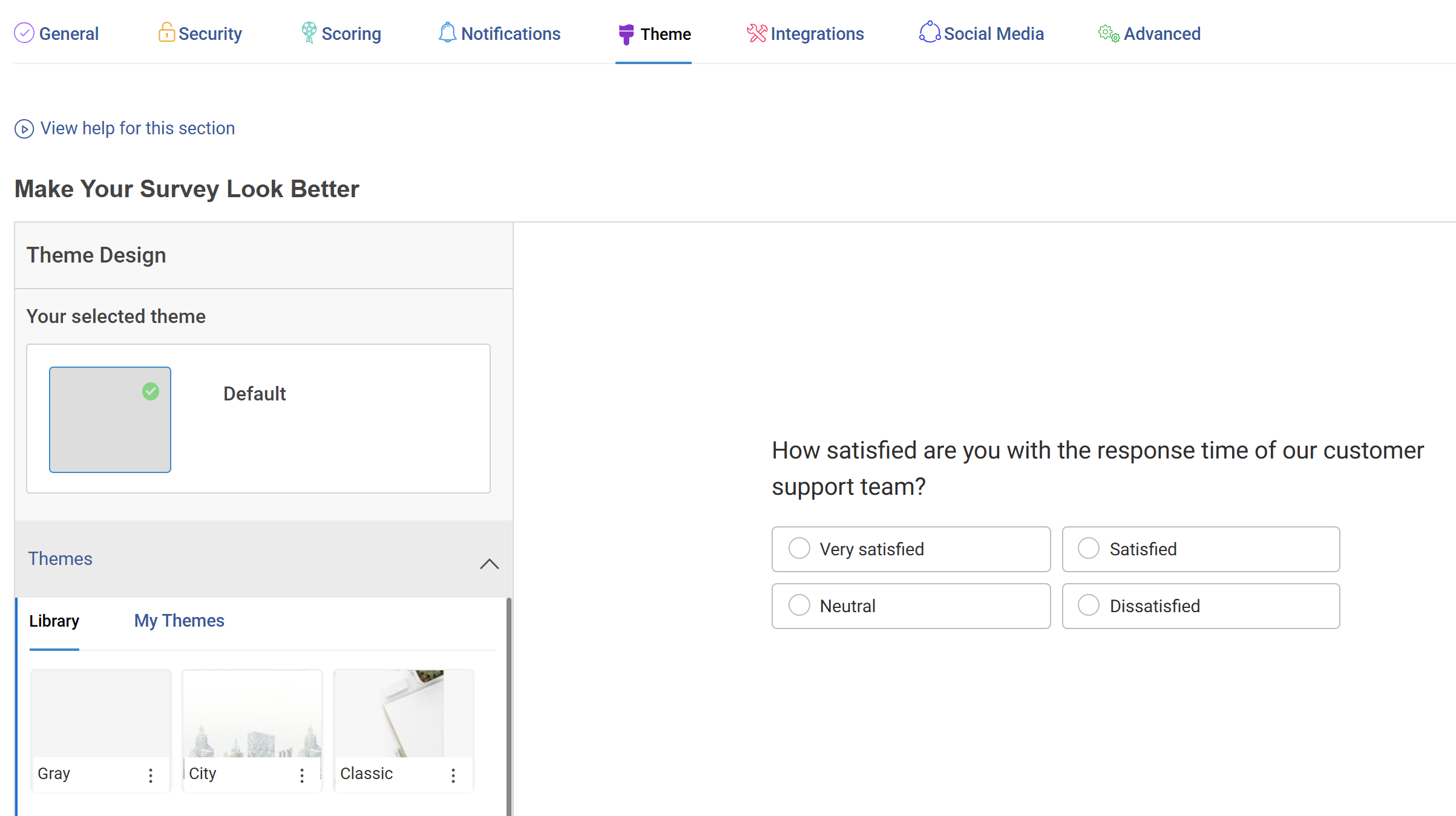
Step 3: Preview & Share in Minutes
Once your survey looks great, preview it to make sure everything’s spot-on. Then share it instantly as a simple link anywhere—email, social media, your website—and start collecting valuable feedback right away.

With Survey Maker and ProProfs AI, creating smart, beautiful, anonymous surveys is a breeze—no technical skills needed, just honest insights waiting to happen.
When Should You Use Anonymous Surveys?
Anonymous surveys are not for every situation. But when you’re trying to uncover sensitive insights—especially those people hesitate to say out loud—they’re indispensable.
Here are the top use cases where anonymous feedback can unlock real truth, along with the ideal tool to use and how to set it up for maximum trust and utility.
1. 360-Degree Feedback for Employees
-
Recommended Tool: ProProfs Survey Maker
-
Why Anonymity Matters: Feedback between peers, managers, and reports can feel political. Anonymity reduces fear of retaliation or awkwardness.
-
What to Ask:
-
“What’s one thing [Name] does well?”
-
“What could they do more of or improve?”
-
“Do you feel comfortable collaborating with them?”
-
-
How to Set It Up:
-
Use Branching Logic to route questions by respondent type (e.g., peer, manager).
-
Disable IP logging and email collection in the privacy settings.
-
Share via internal link or email.
-
Add a clear disclaimer:
“This survey is 100% anonymous. We do not collect IP addresses or personal identifiers.”
-
2. Post-Exit Interview Feedback
- Recommended Tool: Survey Maker
-
Why Anonymity Matters: Departing employees are more likely to share the real reason they’re leaving if they feel protected.
-
What to Ask:
-
“What prompted your decision to leave?”
-
“Were there resources or support missing?”
-
“What could have improved your experience here?”
-
-
How to Set It Up:
-
Use email or public link sharing.
-
Keep it short (4–5 questions max).
-
Avoid demographic or department-level questions that could identify the person.
-
Turn off IP/email tracking.
-
3. Trial Drop-Off Feedback (Why Users Didn’t Convert)
- Recommended Tool: Qualaroo
-
Why Anonymity Matters: Users may blame price, UX, or unmet expectations—but won’t admit it if they think you’ll follow up or upsell them.
-
What to Ask:
-
“What was missing or confusing during your trial?”
-
“What almost made you upgrade—but didn’t?”
-
“What’s one thing that would’ve made you stay?”
-
-
How to Set It Up:
-
Use a Survey triggered on the pricing, dashboard, or cancellation page.
-
Select Sessionless Mode to disable behavioral tracking.
-
Do not pass identifying metadata (like userID, email).
-
Keep to 1–2 quick questions.
-
4. Feature Feedback (Post-Launch or Beta)
- Recommended Tool: Qualaroo
-
Why Anonymity Matters: You want users to be brutally honest about what’s working—and what isn’t. Users might hold back if they know they’re being observed.
-
What to Ask:
-
“Did this feature solve your problem?”
-
“What’s confusing or missing here?”
-
“Would you use this again? Why or why not?”
-
-
How to Set It Up:
-
Trigger the survey only for users who interacted with the feature.
-
Keep survey optional and clearly anonymous.
-
Strip out CRM data and avoid session mapping.
-
5. Diversity, Equity & Inclusion (DEI) or Culture Surveys
- Recommended Tool: Survey Maker
-
Why Anonymity Matters: DEI feedback often involves sensitive, personal experiences. Anonymity ensures psychological safety.
-
What to Ask:
-
“Do you feel a sense of belonging here?”
-
“Have you experienced or witnessed bias?”
-
“What would make the company culture more inclusive?”
-
-
How to Set It Up:
-
Turn off all tracking (IP, email, cookies).
-
Do not ask for gender, ethnicity, or department unless optional.
-
Use GDPR-compliant anonymous mode.
-
Add an intro:
“We respect your privacy. This survey is anonymous and designed to surface honest insights, not trace individual answers.”
-
6. Support Quality or Satisfaction Surveys (Low Volume Feedback)
- Recommended Tool: Qualaroo (or Survey Maker for link-based follow-ups)
-
Why Anonymity Matters: People may downplay negative experiences if they think support agents will see their responses.
-
What to Ask:
-
“Did our team resolve your issue?”
-
“What could have made your support experience better?”
-
-
How to Set It Up:
-
Trigger the survey on a post-support screen or email with Survey Maker link.
-
Keep questions neutral and anonymous.
-
Mention in footer:
“No personal info is collected. This helps us improve without tying feedback to identities.”
-
How Do Anonymous Surveys Work?
Let’s break this down, because “anonymous” means different things to different people. And if you’re running surveys for your product, team, or customers, you need to know how anonymity really works behind the scenes.
First, What Isn’t Anonymous?
Let’s start with the confusion: A lot of tools say a survey is anonymous, but then collect IP addresses, session cookies, or ask for login-based access. That’s not truly anonymous—that’s confidential.
Confidential means the platform knows who answered but promises not to share it. Anonymous means even the platform can’t trace responses back to a person. No IP tracking. No user session IDs. No email capture. Period.
Here’s a quick comparison table for you to skim through:
| Feature | Confidential Survey | Anonymous Survey | |
|---|---|---|---|
| Identity Tracking | Identity is known (e.g., login, email) | No identity collected at all | |
| IP Logging | IP addresses are often stored | IPs are ignored or stripped | |
| Cookies/Session Data | Responses tied to sessions or behavior | No session or cookie tracking | |
| Login/Email Required | Usually required for access or follow-up | Not needed—unless you manually add it | |
| Data Ownership | Data is stored and kept confidential internally | No personal data stored—nothing to protect | |
| User Perception | Can feel risky or intrusive | Feels safe and private—encourages honesty | |
| Best Use Case | When follow-up is needed (e.g., HR reviews) | For sensitive or high-trust feedback |
So… How Does a Truly Anonymous Survey Work?
Here’s what’s happening under the hood (using Qualaroo as an example):
- No IP tracking: The survey tool doesn’t log the IP address of the respondent.
- No cookies/session data: It doesn’t attach responses to browsing sessions or behavioral logs.
- No email, name, or ID required: Respondents aren’t asked for login credentials or identifiers—unless you intentionally add those fields (and even then, they can be optional).
- Link sharing, not user binding: Surveys are shared via public or internal links and are not tied to individual accounts.
So when a user responds to your trial feedback survey, the system literally has no idea who they are, just what they said. That’s what builds trust. That’s what gets you the truth.
Why Anonymous Surveys Matter (Seriously)
Honest feedback is gold, but most people won’t give it if they think their responses can be traced back to them. Anonymity changes that. It creates a space where people can speak their minds, and that’s when the real insights come out.
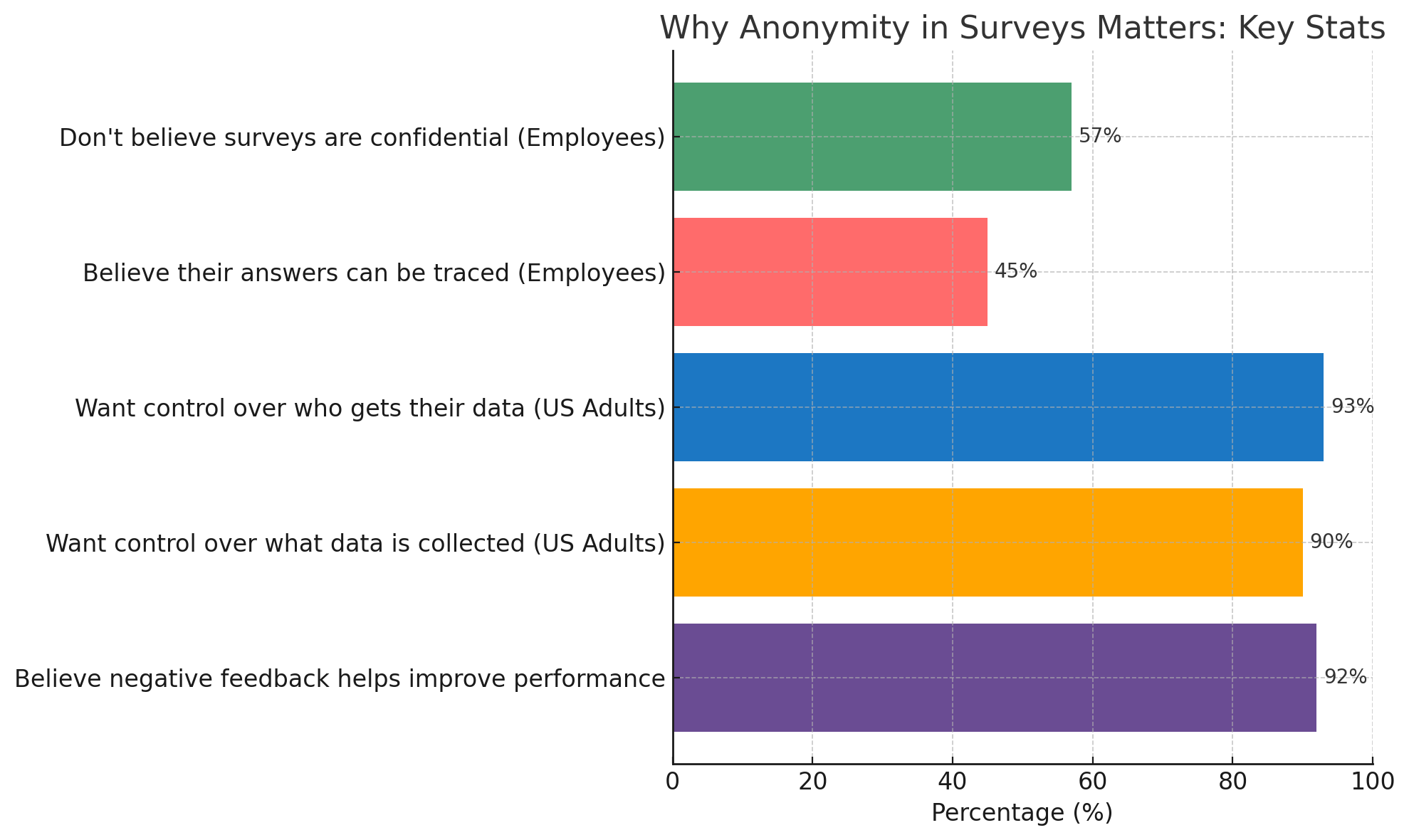
1. Trust Leads to Truth
57% of employees believe workplace surveys aren’t truly confidential, and 45% believe their answers can be traced back to them. When people know their identity won’t be revealed, they’re far more likely to be honest, even blunt. That honesty is what helps you uncover the blind spots, surface hidden issues, and make changes that actually matter.
2. Higher Response Rates
Let’s be real—filling out a survey isn’t on anyone’s bucket list. But if people know it’s anonymous, they’re more likely to hit submit. A vast majority of US adults feel that controlling who gets information about them (93%) and what information is collected (90%) is important.
Anonymity removes hesitation. There’s no second-guessing, no self-editing. That alone can double or even triple your response rates, especially when you’re collecting feedback on sensitive topics.
3. More Useful, Actionable Feedback
Anonymous surveys get you the kind of feedback you actually need—the stuff people won’t say in a customer call, team meeting, or Slack thread. 92% of respondents in one study agreed that when delivered appropriately, even negative feedback effectively improves performance.
Whether you’re trying to improve onboarding, refine messaging, or fix something broken in your process, anonymous surveys help you spot the real friction points—fast.
FREE. All Features. FOREVER!
Try our Forever FREE account with all premium features!
Overcoming Common Concerns in Anonymous Surveys
Let’s Address the Big One: “Is This Really Anonymous?”
This question runs through everyone’s head the moment they open a survey. And if you don’t answer it before they ask, chances are they’ll either drop off or water down their feedback.
Creating anonymous surveys involves careful planning to ensure respondents feel comfortable providing honest feedback without the fear of identification. Here are some tips to help you create an Anonymous Survey:
- Choose a survey platform that supports anonymous responses.
- Avoid personal questions and keep your survey focused on the topic at hand.
- Don’t collect identifying information such as names, email addresses, or IP addresses.
- Assure anonymity by clearly communicating to respondents that their responses are anonymous. You can also provide opt-out and do not track settings for users.
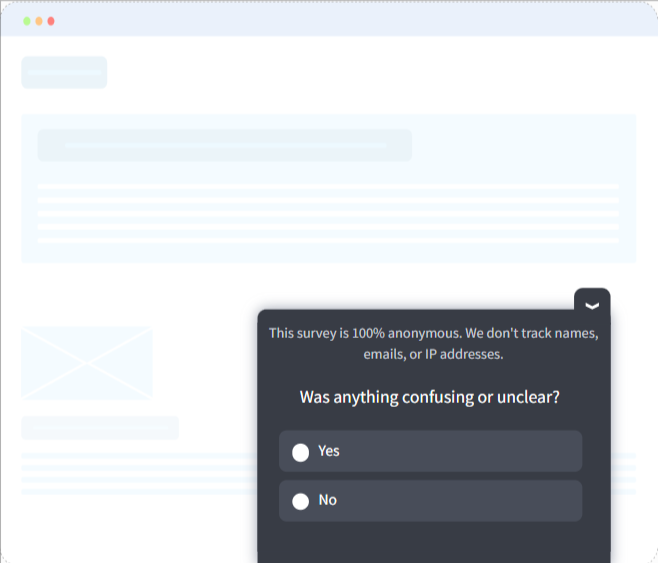
- Randomize the order of response options to minimize bias and prevent respondents from being influenced by the order of choices.
- Use Closed-Ended Questions (multiple-choice, rating scales, etc.) to make it easier to answer anonymously.
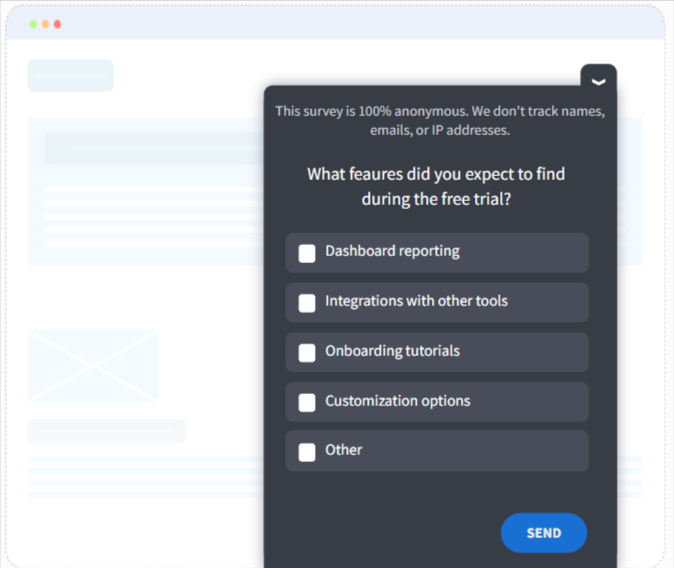
- Offer an Opt-Out option if they feel uncomfortable answering.
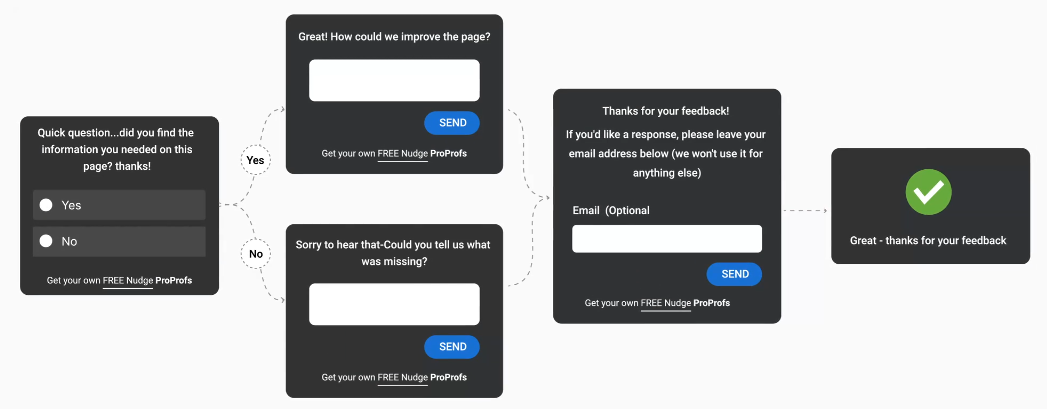
- Limit demographic questions that could potentially identify individuals.
- Before distributing it, test your survey thoroughly to ensure anonymity and that respondents can complete it without any issues.
- Monitor responses regularly to ensure the anonymity of respondents is maintained throughout the survey process.
- If you’re collecting any data, ensure it’s stored securely and access restricted only to authorized personnel.
- Always consider the ethical implications of your survey and ensure it complies with relevant regulations and guidelines, such as GDPR, for surveys conducted in the EU.
Look At How HootSuite Boosted Conversions with a Single Anonymous Survey
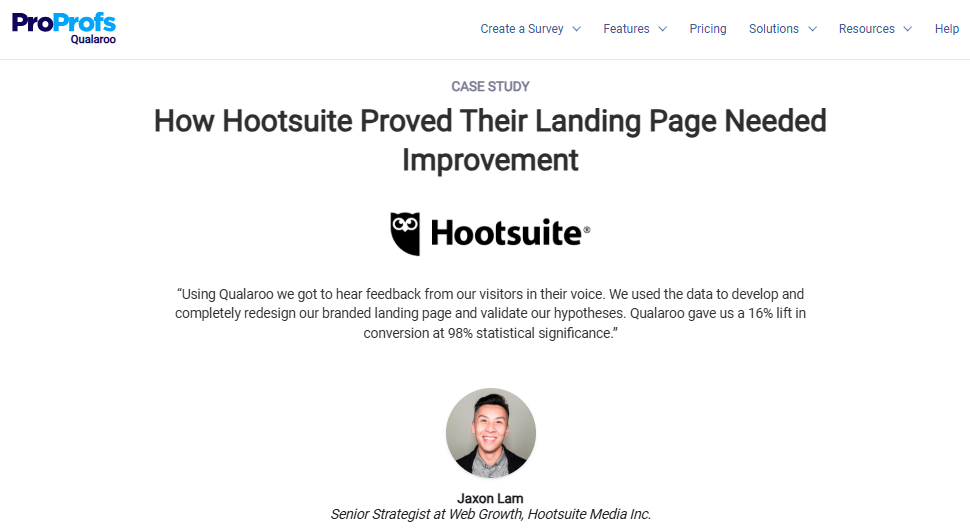
Hootsuite was struggling to convert visitors on a key landing page. Although they assumed the content was clear, visitors weren’t sticking around.
What They Did
Using Qualaroo, they ran a simple, anonymous survey asking:
“Is there enough information on this page to make a decision?”
The result? 65% said no—they needed more clarity before moving forward.
What Changed
Hootsuite updated the page to:
- Clearly explain their value proposition.
- Add product visuals and testimonials.
- Include transparent pricing.
The Result
They ran an A/B test, and the new page led to a 16% increase in conversions with 98% statistical confidence.
Start Gathering Honest Feedback Today
Here’s the bottom line: if you want real answers, you need to make people feel safe sharing them. Anonymous surveys do precisely that—they remove hesitation, build trust, and unlock feedback you can actually use.
And if you’re looking for a tool that makes this process simple—no complex setup, no privacy guesswork—there are platforms out there (like Qualaroo) explicitly designed for that.
Start today. The sooner you ask, the faster you improve.
Frequently Asked Questions
How do I ensure my survey remains truly anonymous?
Easy—don’t pass any identity tags through your survey setup. Qualaroo, for example, only includes identifiable information if you supply it via an embed or API. If you skip that step, nothing traceable is collected.
Can I still follow up with respondents after an anonymous survey?
You can ask for an optional email at the end only if they choose to share contact information—or, if needed, use an identifier like a customer ID before the survey is shown (but this makes it non-anonymous).
What’s the difference between anonymous and confidential surveys?
Surveys can be conducted in different ways depending on how participant information is handled:
- Anonymous: No identity is collected at all (unless you tag it yourself).
- Confidential: Identity is collected but kept private within your system.
What tools should I use to create anonymous surveys?
Use a platform where anonymity is built, like Qualaroo. It doesn’t track identities unless you explicitly pass them, so you're always in control.
 Tips
Tips
We’d love to hear your tips & suggestions on this article!
FREE. All Features. FOREVER!
Try our Forever FREE account with all premium features!

 We'd love your feedback!
We'd love your feedback! Thanks for your feedback!
Thanks for your feedback!


